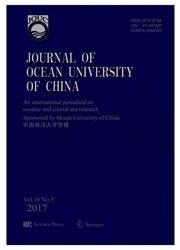

 中文摘要:
中文摘要:
在 2006 的冬季的 Bohai 海和黄海的海洋的动态环境被地区性的海洋建模系统(ROMS ) 水兵模仿数字模型。用模仿的温度和咸度,在 Bohai 海和黄海之间的水交换地区被定义通过光谱混合模型(SMM ) 。水交换上的冬季强风的影响也被讨论。在冬季的黄海水群众在在 Bohai 海峡区域的舌头形状是分布式的,这被发现,水交换地区沿着舌头的边缘介绍带的分布与从西北跑到东南的一个趋势,并且水交换在舌头的尖端被加强。而且,在极北的黄海的沿海的区域不参予在 Bohai 海和黄海之间的水交换。结果证明冬季强风事件在提高水交换起一个作用。它被事实明确地显示出:黄海温暖的水流被提高侵入由强风过程的 Bohai 海;水交换地区延续到 Bohai 海;在南部的部分的水交换带变得更宽;有在它的入口之上的 Bohai 海水的河流量的混合地区向北被扩大并且变。在在强风过程以后的二天以内,向黄海和交换地区的交换地区撤退源于 Huanghe 河(黄河) 流量也朝岸退缩。
 英文摘要:
英文摘要:
The marine dynamic environment of the Bohai Sea and the Yellow Sea in the winter of 2006 is simulated by the Regional Ocean Modelling System(ROMS) marine numerical model. Using the simulated temperature and salinity, the water exchange zone between the Bohai Sea and Yellow Sea is defined through the Spectral Mixture Model(SMM). The influence of winter gales on the water exchange is also discussed. It is found that the Yellow Sea water masses in winter are distributed in a "tongue" shape in the Bohai Strait region, the water exchange zone presents a zonal distribution along the margin of the "tongue", with a tendency of running from northwest to southeast, and the water exchange is intensified at the tip of the "tongue". Besides, the coastal area in the northernmost Yellow Sea does not participate in the water exchange between the Bohai Sea and Yellow Sea. The result shows that the winter gale events play a role in enhancing the water exchange. It is specifically shown by the facts: the Yellow Sea warm current is enhanced to intrude the Bohai Sea by the gale process; the water exchange zone extends into the Bohai Sea; the water exchange belt in the southern part becomes wider; the mixture zone of river runoff with the Bohai Sea water upon its entry is enlarged and shifts northwards. Within two days after the gale process, the exchange zone retreats toward the Yellow Sea and the exchange zone resulted from the Huanghe River(Yellow River) runoff also shrinks back shoreward.
 同期刊论文项目
同期刊论文项目
 同项目期刊论文
同项目期刊论文
 期刊信息
期刊信息
